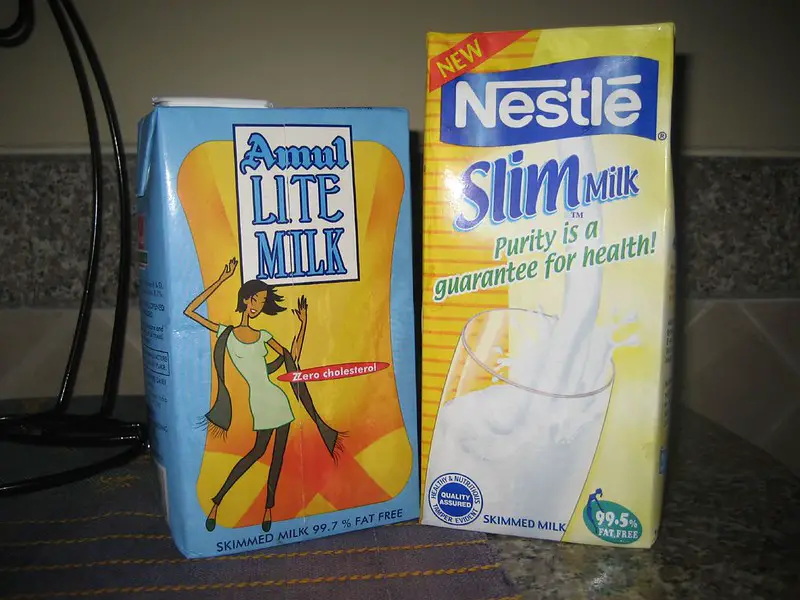Whole milk contains more fat and calories, it also provides essential nutrients such as vitamin D and calcium. On the other hand, skim milk has fewer calories and less fat but still offers a good source of protein. In terms of taste, both types have their own distinct flavor profiles that can vary based on brand and processing methods. Some people prefer the creaminess of whole milk while others enjoy the lighter taste of skim.
Skim Milk
(Photo By Nick Gray on Flickr)

Skim milk, also known as fat-free or nonfat milk, is a popular choice for people who want to reduce their calorie and fat intake. Skim milk is made by removing all the cream from whole milk through a separation process.
One of the main benefits of skim milk is that it’s low in calories and fat. A cup of skim milk contains only about 80 calories and less than 1 gram of fat, making it an ideal option for those looking to lose weight or maintain a healthy diet.
But while skim milk may be lower in calories and fat compared to whole milk, it’s important to note that some nutrients are also lost during the separation process. Skim milk has fewer vitamins A and D compared to whole milk but usually fortified with these vitamins.
Despite its lower caloric content, many people find that skim milk tastes watery compared to whole milk due to its reduced-fat content. However, adding flavorings like vanilla extract or mixing with cocoa powder can make it more palatable.
If you’re looking for a low-calorie option without sacrificing too much on nutrition value then skimmed-milk might just be right for you!
Whole Milk
(Photo By Mike Mozart on Flickr)

Whole milk, also known as full-fat milk, is a type of dairy product that has not been altered or had any fat removed from it. It contains approximately 3.25% milkfat and is the closest to its natural state when compared to other types of milk.
Many people prefer whole milk due to its creamy texture and rich taste. However, some individuals may choose skim or low-fat options for health reasons such as weight management or cholesterol levels.
Whole milk is an excellent source of essential vitamins and minerals such as calcium, vitamin D, and potassium which are important for maintaining strong bones and teeth. Additionally, it provides energy through carbohydrates and healthy fats which are necessary for various bodily functions.
While whole milk may have more calories than skim or low-fat options, studies have shown that consuming full-fat dairy products can actually aid in weight loss by promoting satiety and reducing overall caloric intake throughout the day.
Choosing whether to consume whole milk over other variations ultimately depends on individual preferences and dietary needs. Nevertheless, incorporating moderate amounts of whole milk into a balanced diet can provide numerous benefits for one’s health.
Skim milk Vs. Whole milk – Key differences
Skim milk and whole milk are two common types of cow’s milk, but they differ in several ways. Skim milk is also known as non-fat or fat-free milk because it has little to no fat content. On the other hand, whole milk contains all of the natural dairy fats which give it a creamier texture.
The main difference between skim and whole milk is their calorie and fat content. Whole milk contains around 146 calories per cup while skim milk only has about 83 calories per cup. Additionally, one cup of whole milk provides approximately 8 grams of fat compared to less than half a gram in a serving of skimmed.
Another key difference between these two types of dairy products is their taste and texture. Whole Milk has a creamy texture due to its high-fat content, whereas Skim Milk tends to be lighter and watery with much less noticeable flavour since most flavours come from the fatty acids present in full-fat options.
When deciding whether to choose skim or whole milks for your personal preference, health goals play an important role: people aiming for weight loss might opt for skim over whole; however those who need energy may prefer the fuller flavor profile found naturally occurring in foods featuring more saturated fats like that found within animal products such as butterfat-heavy cream cheeses (think brie) – this latter choice offers greater satisfaction when eating which can lead you not snacking soon after eating just to fill up again!
The different types of milk
There are several types of milk available in the market today, each with its own unique features and benefits. The most common types of milk include whole milk, skimmed milk, almond milk, soy milk, and lactose-free milk.
Whole Milk is high in fat content and has a creamy texture that makes it ideal for cooking and baking. Skimmed Milk contains little to no fat content which makes it perfect for individuals who want to reduce their calorie intake while still enjoying the nutritional value of milk.
Almond Milk is made from ground almonds mixed with water. It has a nutty flavor and is low in calories making it an excellent choice for people on a weight loss diet. Soy Milk is rich in protein content which makes it suitable for vegetarians or people who are lactose intolerant.
Lactose-Free Milk does not contain lactose which means that individuals who have difficulty digesting lactose can still enjoy the benefits of drinking milk without experiencing any negative side effects.
Choosing the right type of milk depends on your needs as well as personal preferences. Whether you prefer a creamy texture or a nutty flavor, there’s always something out there that will suit your taste buds!
The benefits of Skim Milk
Skim milk, also known as fat-free or nonfat milk, has several benefits that make it a popular choice among health-conscious individuals. Here are some of the benefits of drinking skim milk:
- Low in Calories: Skim milk contains fewer calories than whole milk because it has no fat. This makes it an excellent option for those who want to lose weight or maintain their current weight.
- High in Protein: Skim milk is a great source of protein, which is essential for building and repairing muscles.
- Lowers Cholesterol Levels: Since skim milk has no fat content, it can help lower cholesterol levels and reduce the risk of heart disease.
- Rich in Vitamins and Minerals: Skim milk is packed with vitamins and minerals like calcium, vitamin D, potassium, phosphorus, and magnesium which are vital for strong bones and teeth.
- Good for Digestion: The lactose present in skimmed milk helps improve digestion by promoting the growth of good bacteria in the gut.
- Helps Hydrate Your Body: Drinking more water can sometimes become boring; however adding skimmed-milk to your diet can help keep you hydrated throughout the day due to its high water content.
If you’re looking for a low-calorie drink that’s rich in nutrients while helping your body shed excess pounds then opting for a glass of cold-skimmed-milk may be just what you need!
The benefits of Whole Milk
Whole milk is packed with nutrients that provide numerous benefits to the body. Here are some of the most important benefits of whole milk:
Firstly, whole milk contains high amounts of calcium and phosphorus, which are essential for strong bones and teeth. Drinking whole milk regularly can help prevent osteoporosis, a condition where bones become brittle and weak.
In addition to its bone-strengthening properties, whole milk also contains healthy fats that promote heart health. Contrary to popular belief, these natural fats do not increase cholesterol levels or contribute to weight gain when consumed in moderation.
Whole milk is also rich in vitamins A and D. Vitamin A helps maintain healthy skin and eyesight while vitamin D aids in calcium absorption.
Furthermore, studies have shown that consuming dairy products like whole milk can lower the risk of developing type 2 diabetes by improving insulin sensitivity.
Drinking whole milk may even aid in weight loss due to its high protein content which promotes feelings of fullness and reduces cravings for unhealthy snacks.
Featured Image By – Aleksey Melkomukov on Unsplash








